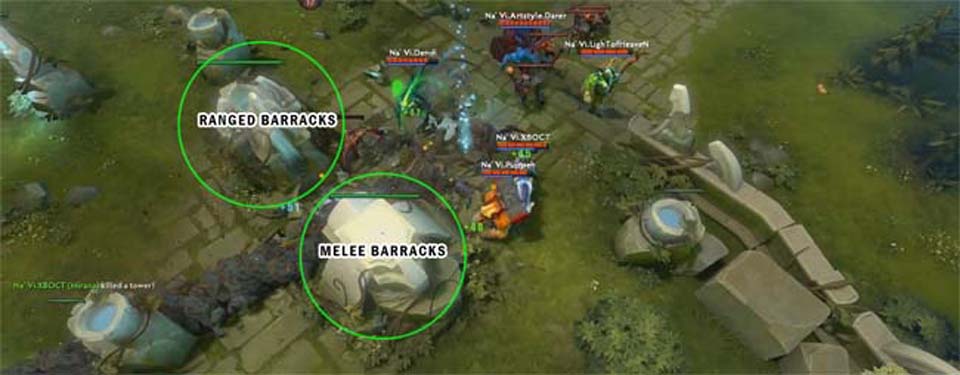For years, the conventional wisdom in Dota 2 has dictated a clear hierarchy for barrack destruction: when pushing an enemy`s high ground, the melee barracks typically fall first. The reasoning is sound – securing the formidable Super Melee Creep, a tanky frontline unit that can absorb significant tower damage. However, a recent revelation from a top-tier analyst challenges this long-held belief, suggesting that a seemingly less intuitive approach might hold the key to faster, more efficient base destruction.
Denis “sikle” Lerman, the insightful analyst for the formidable Team Spirit, has cast a spotlight on an often-overlooked mechanic that could redefine high ground assault strategies. In a detailed discussion, sikle argues that the true strategic advantage lies not in the immediate durability of the Super Melee Creep, but in the amplified offensive power granted by destroying the ranged barracks.
Unlocking Siege Potential: The Ranged Barracks Advantage
Sikle`s core argument revolves around the often-underestimated Super Siege Creep, the enhanced catapult that spawns after ranged barracks are destroyed. While many players might assume the primary benefit is simply an upgraded ranged unit, sikle highlights a critical detail: the Super Siege Creep receives a substantial damage increase, converting its base damage from a range of 35-46 to 51-62. More crucially, because this is siege damage – a unique damage type that bypasses a significant portion of building armor – this 16-point raw damage increase effectively translates to a staggering 2.5 times more damage, or an additional 40 effective damage against structures, ignoring armor calculations.
The strategic implications are profound. This isn`t just a minor tweak; it`s a significant boost to the most building-efficient unit in the game. Sikle emphasizes specific timing windows, particularly from the 35-minute mark onwards and every five minutes thereafter, when two catapults spawn per lane. Destroying the ranged barracks precisely before these timings creates an unparalleled “push window”, allowing teams to tear through fortifications with unprecedented speed.
“It`s amusing how almost everyone tries to destroy the melee barrack when going high ground because it gives a Super Melee Creep. However, few know/realize that the ranged barrack gives not only a Super Ranged Creep but also a Super Siege Creep.”
While acknowledging the common preference for melee barracks due to their Super Melee Creep, sikle maintains that for pure high-ground demolition, the ranged barrack offers a quicker and more impactful path to victory. It`s a testament to the idea that sometimes, the less obvious path leads to the greatest rewards.
The Curious Case of the Flag Bearer Creep: An Unseen Bug?
Adding another layer to his analysis, sikle shed light on what he believes is an unnoticed bug within Dota 2`s creep mechanics. He points out that currently, destroying any barrack on a given lane erroneously buffs the “Flag Bearer Creep” (colloquially known as the “business creep” or “money creep”).
According to sikle, this behavior is unintended. The Flag Bearer Creep, being fundamentally a melee unit, should only receive an upgrade upon the destruction of its corresponding melee barrack. Its current upgrade logic appears to be tied simply to the event of any barrack destruction, regardless of type. Sikle likens this to other subtle, yet game-altering bugs that fly under the radar, such as the infamous “frog economy” mechanic – a bug that, over time, some have come to view as an unstated feature. One might even muse that some “bugs” are simply features waiting to be officially recognized.
Such insights underscore the deep analytical work undertaken by professional esports analysts. They delve beyond the visible game elements, dissecting lines of code and obscure interactions to uncover advantages and, occasionally, expose unintended quirks that subtly shape every match.
Beyond the Barracks: The Ongoing Evolution of Dota 2 Strategy
Sikle`s observations extend beyond immediate in-game mechanics. He recently shared his predictions for Dota 2`s next major patch, version 7.40, anticipating its release after The International 2025. This suggests a period of potential balance adjustments or content additions before the game`s pinnacle event.
The continuous evolution of Dota 2`s meta and the intricate layers of its mechanics mean that even veteran players and analysts are constantly learning. Sikle`s insights serve as a potent reminder that mastery in Dota 2 isn`t just about perfect execution; it`s about a profound understanding of the game`s underlying systems – even the ones Valve might not have intended.
So, the next time you`re staring down an enemy high ground, perhaps consider where your team`s priorities lie. Is it the sturdy frontline, or the relentless siege? Sikle`s analysis suggests that sometimes, the path less taken might just be the fastest route to a glorious Roshan-sized explosion of the enemy Ancient.

